Features
Witness to a mass murder
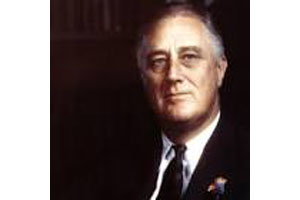
By DAVID and MILTON AMMEL Special to The Jewish Post & News Attacks on Jews have seen a sharp upsurge in recent years…indeed, many sources believe the epidemic of violence against Jews is the worst since Hitler. (In the latest perversion, some are even trying to blame the Jews for the Covid 19 pandemic!) The fact that 6 million Jews (or more) died in Hitler’s holocaust is beyond question; there are two questions that have faced the world ever since World War Two: 1. Did Allied leaders fighting Hitler know about the death camps long before their existence was known to the world? and 2. If the allies did know about it, then why wasn’t something done to at least limit Hitler’s atrocities?
We provide some answers in this article that have been overlooked by many…answers that some powers to be may not like. But truth is truth, and it’s past time to see what was really going on in the early days of World War II.
There has been a widespread belief among most historians that President Roosevelt, Winston Churchill and others had no idea of the scale of mass slaughter until the very end of the war when the death camps were finally liberated. But is this true? For the purposes of this article, we will limit our discussion to what Roosevelt surely knew.
By all accounts, President Roosevelt only had one meeting with Jewish leaders about the ongoing Holocaust, and this took place in December 1942. American Jewish leaders managed to arrange a meeting with President Franklin D. Roosevelt about the already tragic situation in Europe. A review of the meeting demonstrates a shocking lack of any great concern about the plight of the Jews, even after he acknowledged he knew what was transpiring. A report of the meeting is contained in the “Jewish Virtual Library” and we will quote extensively from this account that shows the President already knew about the death camps already in operation.
After the State Department confirmed reports that Hitler was planning to murder all the Jews in territories under German control, several American Jewish leaders including Rabbi Stephen Wise managed to arrange an audience with President Roosevelt. At this 29-minute meeting, the only one FDR had with Jewish leaders about the Holocaust, the President was presented with a document outlining the Nazi plan to annihilate European Jews. Adolph Held, the president of the American Jewish Labor Committee, wrote this report of the meeting, which indicates the president was acquainted with details of the atrocities being committed by the Nazis:
“The committee consisted of Rabbi Stephen S. Wise, of the Jewish Congress; Mr. Monsky, of Bnai Brith; Rabbi Rosenberg, of the Agudath, and Adolph Held, of the Jewish Labor Committee.
“The meeting with the President was arranged for Tuesday, December 8, 1942, at 12 o’clock. We were originally notified that the President would give us 15 minutes, but the conference lasted 29 minutes. The purpose of the conference was to present a prepared memorandum on the German atrocities in Poland consisting of an appeal to the President for immediate action against the German extermination of Jews, and also a 12 page memorandum citing the facts that have been gathered on this subject.”
After a few brief introductory remarks, the meeting got down to business.
Rabbi Wise then read the declaration by the committee.
“Rabbi Wise did not read the details but simply said: “Mr. President, we also beg to submit details and proofs of the horrible facts. We appeal to you, as head of our government, to do all in your power to bring this to the attention of the world and to do all in your power to make an effort to stop it.”
“The President replied: “The government of the United States is very well acquainted with most of the facts you are now bringing to our attention. Unfortunately we have received confirmation from many sources. Representatives of the United States government in Switzerland and other neutral countries have given us proof that confirm the horrors discussed by you. We cannot treat these matters in normal ways. We are dealing with an insane man- Hitler, and the group that surrounds him represent an example of a national psychopathic case. We cannot act toward them by normal means. That is why the problem is very difficult. At the same time it is not in the best interest of the Allied cause to make it appear that the entire German people are murderers or are in agreement with what Hitler is doing. There must be in Germany elements, now thoroughly subdued, but who at the proper time will, I am sure, rise, and protest against the atrocities, against the whole Hitler system. It is too early to make pronouncements such as President Wilson made, may they even be very useful. As to your proposal, I shall certainly be glad to issue another statement, such as you request.”
So, saving Jewish lives is “very difficult” because Hitler is insane?
There followed a discussion of possible options to help the Jews, and then FDR made these remarks.
“The President then plunged into a discussion of other matters. “We had a Jewish problem in North Africa” — he said. “As you know, we issued orders to free all the Jews from concentration camps, and we have also advised our representatives in North Africa to abolish all the special laws against the Jews and to restore the Jews to their rights. On this occasion I would like to mention that it has been called to our attention that prior to the war, Jews and Frenchmen enjoyed greater rights than Moslems in some of the North African states. There are 17 million Moslems in North Africa, and there is no reason why anyone should enjoy greater rights than they. It is not our purpose to fight for greater rights for anyone at the expense of another group. We are for the freedom for all and equal rights for all. We consider the attack on the Jews in Germany, in Poland, as an attack upon our ideas of freedom and justice, and that is why we oppose it so vehemently.” “Now you are interested in the Darlan matter. I can only illustrate this by a proverb, I recently heard from a Yugoslav priest—”When a river you reach and the devil you meet, with the devil do not quarrel until the bridge you cross.”
These Jewish leaders were beseeching Roosevelt to stop the genocidal mass-murders of Jews going on in Europe!! They were not asking him for “greater rights….at the expense of another group!
“Apparently, at the end of this quotation the President must have pushed some secret button, and his adjutant appeared in the room. His eyes and broad shoulders showed determination. We rose from our seats, and, as we stood up, the President said: “Gentlemen, you can prepare the statement. I am sure that you will put the words into it that express my thoughts. I leave it entirely to you. You may quote from my statement to the Mass -Meeting in Madison Square Garden some months ago, but please quote it exactly. We shall do all in our power to be of service to your people in this tragic moment.”
“The President then shook hands with each of us, and we filed out of the room.”
Contained in this narrative already are suspicions that FDR may have harbored prejudices against Jews. At best FDR appeared to be indifferent about the Holocaust, which he admitted he already was aware of. At worst it would be like a witness to a murder who does nothing to stop the crime.
Another troubling glimpse of Roosevelt’s view of Jews is an article published in the May, 2018 issue of the Jerusalem Post. The article was entitled “FDR wanted Jews spread thin and kept out of the U.S., documents reveal.”
These documents from the FDR Library reveal something called the “M Project” which was a study commissioned by Roosevelt to study the migration of millions of peoples displaced by the War, most of them Jews.
“Describing the M Project to UK Prime Minister Winston Churchill in 1943, Roosevelt said the study is focused on “the problem of working out the best way to settle the Jewish question,” adding that the solution “essentially is to spread the Jews thin all over the world,” rather than allow them amass in large numbers in one specific place. The conversation was recorded in the diary of Vice President Henry Wallace, who was present at the meeting.”
This all points to a shocking realization that Roosevelt’s view of Jews was that they were a race of troublemakers, to be scattered all over the planet to minimize their chances of gaining any meaningful power.
Another claim that many historians use in excusing the allies in their refusal to help the Jews in the death camps is the claim that it would divert considerable resources from the air campaign, and so would not be worthwhile.
An article in “The National Interest” dated October 8, 2017 asks the question: “Could the Allies Have Stopped the Killing at Auschwitz Sooner?” What follows is a discussion of the supposed dilemma military planners faced, which included their claim that the death camps were out of range of the bombers. For the purposes of this article, we take notice of these facts.
“In considering the feasibility of bombing Auschwitz, one needs to know if the Western governments knew about the world’s largest killing center. The answer is a definitive yes. As historian Tami Davis Biddle has discovered, the first report about Auschwitz was made as early as January 1941—only six months after it had opened and before the gas chambers were installed. A report from the Polish underground was sent to the Polish government in exile in London, where it was forwarded on to Sir Charles Portal, the chief of the British Royal Air Force. The report said Auschwitz was one of the Nazis’ “worst organized (sic) and most inhuman concentration camps.”
“The American public was first introduced to the horrors of Auschwitz on November 25, 1942, when the New York Times published an article on page 10 that stated, “Trainloads of adults and children [are] taken to great crematoriums at Oswiencim [Auschwitz], near Cracow.” In March 1943, the Directorate of Civilian Resistance in Poland reported that 3,000 people a day were being burned in a new crematorium at Auschwitz.”
Roosevelt knew everything that was going on in this German genocide of the Jews, including every detail of it.
It is a brutal fact that an unending stream of reliable reports from various sources in various parts of Europe were provided to Allied forces.
“It was also discovered after the war that by the time Auschwitz had been liberated the Allies had photographed the camp at least 30 times during the course of the war. The photos, taken by the U.S. Army Air Forces, were stored at the Mediterranean Allied Photo Reconnaissance Wing in Italy, which was commanded by President Franklin D. Roosevelt’s son, Colonel Elliott Roosevelt. Some photos even showed inmates being marched to the gas chambers.”
What about the claim that Auschwitz (and other death camps) was beyond the range of bombers?
“By May 1944, the USAAF had begun attacking the Third Reich’s synthetic oil plants located in Germany, Poland, and Romania. The goal was to bring Hitler’s war machine to a halt. On August 8, 1944, a raid numbering 55 bombers from the U.S. Eighth Air Force flew from airfields in the Soviet Union and dropped more than 100 tons of bombs on an oil refinery at Trzebinia, which was approximately 20 miles northeast of Auschwitz.” (emphasis ours.)
One more question that many have asked: considering that Jews and other fated people were brought in on railroad cars….wouldn’t bombing the railroad lines have hindered the death camps? The argument to that question is pretty much the same as others: bombing the death camps would’ve done no good because it would’ve killed inmates, they were out of reach, would’ve required too much diversion of air power, etc etc.
Strangely enough, even the Pope has gotten in on the last controversy. An article from the “Independent” from June 22 2015 carries the title “Pope Francis: Why didn’t allies bomb railway routes taking prisoners to Auschwitz?”
‘’The great powers had photographs of the railway routes that the trains took to the concentration camps, like Auschwitz, to kill the Jews, and also the Christians, and also the Roma, also the homosexuals,” Pope Francis said.
“Tell me, why didn’t they bomb” those railroad routes?”
In a 2004 interview concerning the bombing missions he flew as a young bomber pilot by Auschwitz, Senator and 1972 Presidential candidate George McGovern said, “FDR was a great man and he was my political hero. But…he made….the decision not to go after Auschwitz…God forgive us….there was a pretty good chance we could have blasted those rail lines off the face of the earth (and) interrupted the flow of people to those death chambers, and we had a pretty good chance of knocking out those gas ovens.” (December 2004 interview with Israel Television and the David S. Wyman Institute for Holocaust Studies.)
Indeed, many experts now say that with a bomb load of 8000 pounds, only six of our bombers would have obliterated the rail line, the death chambers, the gas ovens, and the SS barracks.
The same could have been done to the other five death camps.
As for the real possibility that some inmates would be killed….think about this. Their fate was already sealed. So in the long run, it obviously would’ve saved many inmate lives overall.
We now turn to the question: we have established that FDR and others knew all about the death camps very early in the war….so when did Roosevelt begin to refuse helping the Jews?
It started even before World War II!
The steamship M.S. St. Louis, having crossed the Atlantic Ocean with over 900 German-Jewish passengers desperate to escape Nazi Germany, is steaming off the coast of Miami, Florida for about two weeks in June 1939. The passengers have formed a committee and are begging the U.S President himself for sanctuary in the U.S. Roosevelt refuses.
U.S. Immigration authorities then send the ship back to Europe. This rejection is a death sentence to many on the ship at the Nazis’ hands.
Throughout the following war, Roosevelt rejected all requests made by Jewish leaders to bomb the gas chambers or the rail line at Auschwitz.
When it comes to the unspeakable blood on his hands’ guilty refusal to save 2,000,000 or more men, women and children’s lives, Jewish and others, Franklin Delano Roosevelt has no excuse.
His actions are the utter opposite of a “great man.”
The ending of this tragedy only came when World War II ended in Allied victory. But many millions of innocent human beings never lived to see that victory and their salvation….in large part due to the tragic indifference of a U.S. President.
Features
History of the Winnipeg Beach Synagogue: 1950-2025

By BERNIE BELLAN The history of the Winnipeg Beach Synagogue is a fascinating one. We have had several articles over the years about the synagogue in The Jewish Post & News.

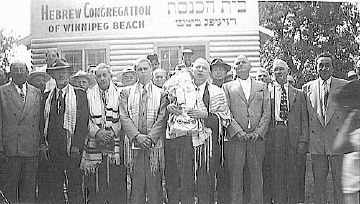
In June 2010 I wrote an article for The Jewish Post & News upon the 60th anniversary of the synagogue’s opening. Here are the opening paragraphs from that article:
“Sixty years ago a group of Winnipeg Beach vacationers decided that what their vacation area lacked was a synagogue. As it happened, a log cabin one-room schoolhouse in the Beausejour area happened to be available.
“In due course, the log cabin was relocated to the corner of Hazel and Grove in Winnipeg Beach, where it stayed for 48 years.”
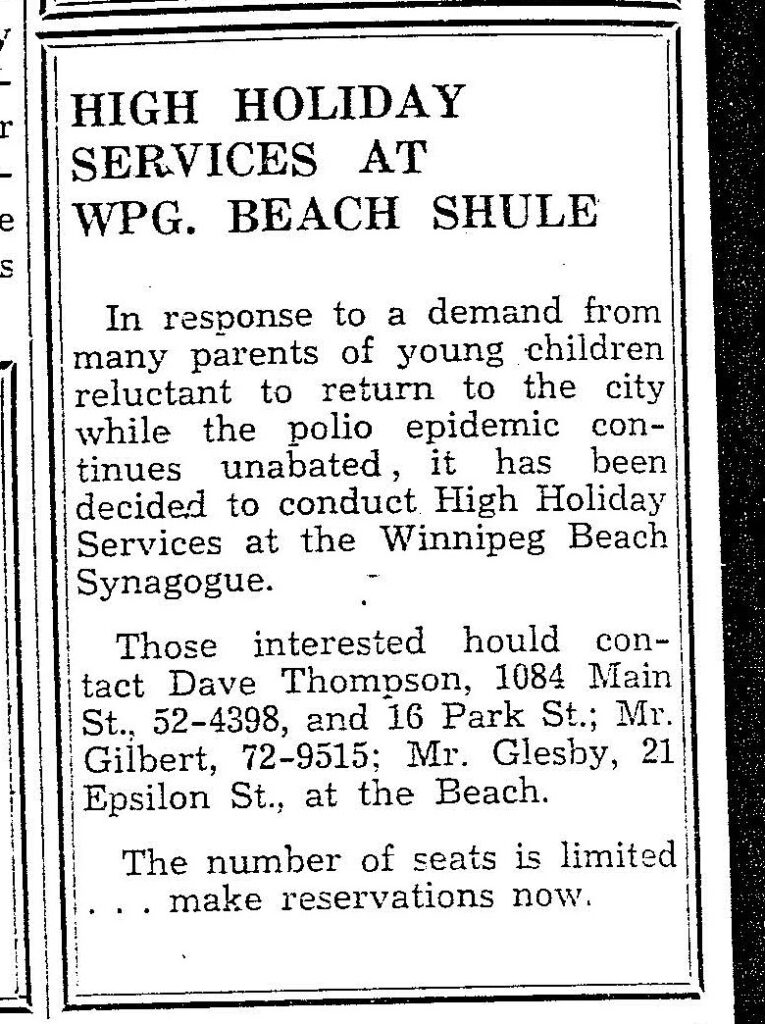
In December 1994 my late brother, Matt, wrote a story about the spraying of antisemitic grafitti on the synagogue which, at that time, was still situated at its original location on the corner of Hazel and Grove in the town of Winnipeg Beach:
“Two 16-year-olds spraypainted slogans like ‘Die Jews,’ ‘I’ll kill you Jews,’ and other grafitti in big letters on the beach synagogue.
“Jim Mosher, a news reporter for the Interlake Spectator in Gimli, said last Halloween’s vandalism against the synagogue wasn’t the first. In the late 1980s, he claimed, it was spraypainted with swastikas.
“Jack Markson, a longtime member of the Winnipeg Beach Synagogue, last week also said he could remember finding anti-Semitic grafitti spraypainted on the synagogue ‘a few years ago,’ and at least twice in the 1970s, when the cottage season was over.”

My 2010 article continued: “In 1998 the Town of Winnipeg Beach informed the members of the synagogue that the building would have to be hooked up to the town’s sewer and water system. Rather than incur the cost of $3-4,000, which was thought to be ‘prohibitive,’ according to longtime beach synagogue attendee Laurie Mainster, synagogue goers looked elsewhere for a solution.
“As a result, the board of Camp Massad was approached and asked whether the synagogue might be relocated there, with the understanding that the synagogue would be made available to the camp at any time other than what were then Friday evening and Saturday morning services.
“Over the years the ‘beach synagogue’ had come to be a very popular meeting place for summertime residents of Winnipeg Beach and Gimli. In fact, for years minyans were held twice daily, in addition to regular Saturday morning services. Of course, in those years Winnipeg Beach was also home to a kosher butcher shop.
“While the little synagogue, which measured only 18 x 24 feet, has gone through several transformations, including the move to Camp Massad, and the opening up to egalitarian services in 2007 (The move to egalitarian services was as much a practical necessity as it was a nod to the equality of women – the only Kohen present at the time was a woman!), it has always remained cramped at the best of times.
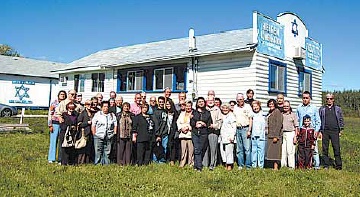
“In recent years the synagogue has seen the addition of a window airconditioner (although to benefit from it, you really have to be sitting just a few feet away), as well as a fridge that allows synagogue attendees to enjoy a regular Saturday morning Kiddush meal following the service.
“According to Laurie Mainster, the Saturday morning service has continued to be popular, even though many of the attendees now drive in from Winnipeg, as they have sold the cottages they once maintained.
“On the other hand, one of the side benefits to being located on Camp Massad’s grounds has been an infusion of young blood from among the camp counsellors.
“Since there is no longer a rabbi available to conduct services (Rabbi Weizman did lead services for years while he had a cottage at the beach), those in attendance now take turns leading the services themselves.
“Anyone may attend services and, while there are no dues collected, donations are welcome. (Donations should be made to the Jewish Foundation of Manitoba, with donors asked to specify that their donations are to be directed to the beach synagogue.)
“Mainster also says that the beach synagogue is now undergoing an expansion, which will be its first in 60 years. An entirely new space measuring 16 x 18 feet is being added – one that will allow for a real Kiddush area. (Until now, a table has been set up in the back of the synagogue and synagogue goers would help themselves to the buffet that is set up each Saturday during the summer. While pleasant enough, it will certainly be more comfortable to have an actual area set aside for the Saturday afternoon after service lunch.)
“As for dress, longtime attendee Abe Borzykowski (in an article written by Sharon Chisvin for the Free Press in 2007) remarked that ‘I don’t think there are many synagogues where people can attend in shorts, T-shirts and sandals and not feel out of place.’ “
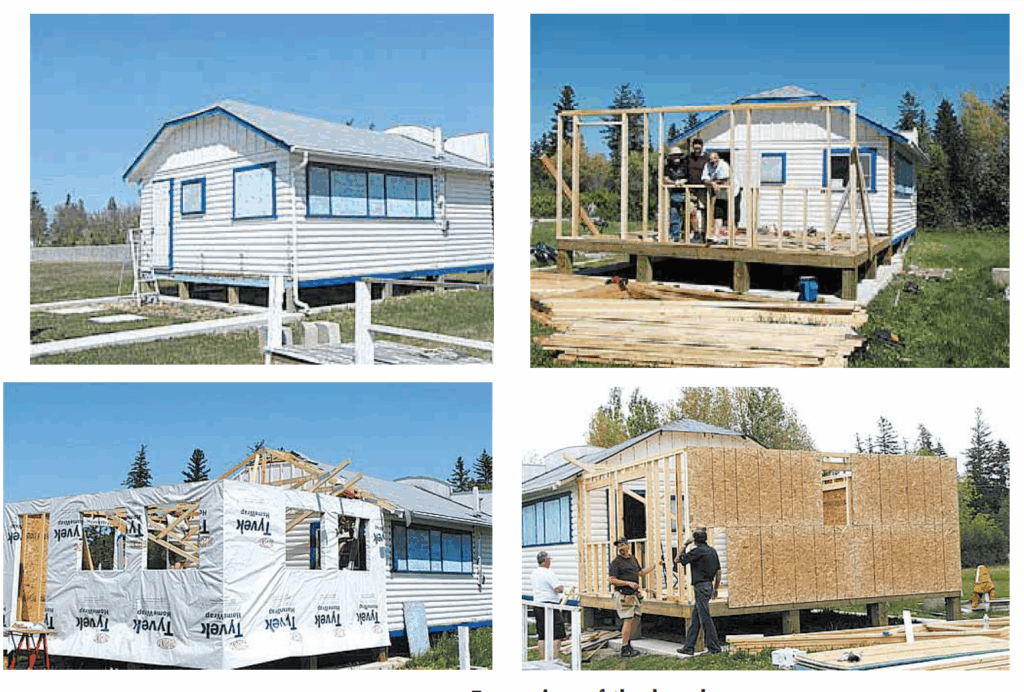
As mentioned in that 2010 article, the beach synagogue at that time was about to undergo an extensive remodelling. Here is an article from a January 2011 issue that describes that remodelling process. The article was written by Bernie Sucharov, who has been a longtime member of the beach synagogue:
“The Hebrew Congregation of Winnipeg Beach made a major change to the synagogue this past summer. With the help of many volunteers, Joel Margolese being the project manager, the synagogue was expanded and an addition was built to handle the overflow crowds, as well as to add more space for the kiddush following services.
“The volunteers spent many Sundays during the summer months building the addition. Bad weather caused many delays, but finally the addition was completed one week before the official summer opening.
“The volunteers were: Joel Margolese, Gordon Steindel, Sheldon Koslovsky, Viktor Lewin, Harvey Zabenskie, Nestor Wowryk, Kevin Wowryk, Victor Spigelman, Jerry Pritchard, and David Bloomfield.
“On Sunday, June 25, 2010 a special ceremony was held to affix a mezzuzah to the front entrance door. Gordon Steindel had the honour of affixing the mezzuzah, which was donated by Sid Bercovich and Clarice Silver.
“Refreshments and food for the day were prepared by Phyllis Spigelman, also known as our catering manager. Throughout the summer, Phyllis, Lenore Kagan and other friends prepared the food for our kiddush.
“A sound system was donated by Arch and Brenda Honigman in memory of their father, Sam Honigman z”l. “The system was installed by Joel Margolese and Stevan Sucharov. This will allow the overflow crowd to hear the service in the new addition.
“There were also generous donations of 50 chumashim and an air conditioner. The chumashim were donated by Gwen, Sheldon and Mark Koslovsky. The air conditioner in the new addition was donated by Joel and Linda Margolese.
“The official opening of the synagogue for the summer took place on July 3, 2010. We had an overflow crowd of 70+ people.”
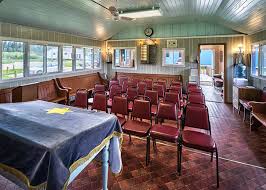
Since that 2010 major addition to the synagogue, it has also added a wheelchair ramp (although I’ve been unable to ascertain exactly when the ramp was built). Also, the synagogue also has its own outdoor privy now. (Attendees used to have to use facilities in Camp Massad.)
And, as already noted in article previously posted to this site (and which you can read at Beach Synagogue about to celebrate 75th anniversary), in recognition of that occasion, on August 2nd members of the synagogue will be holding a 75th anniversary celebration.
As part of the celebration anyone who is a descendant or relative of any of the original members of the first executive committee is invited to attend the synagogue that morning.
If you are a relative please contact Abe Borzykowski at wpgbeachshule@shaw.ca or aborzykowski@shaw.ca to let Abe know you might be attending.
Features
Kinzey Posen: CBC Winnipeg’s former “go-to guy”

By GERRY POSNER If former Winnipegger Lawrence Wall was the CBC go-to guy in Ottawa, CBC Winnipeg had its own version of a go-to guy for many years with none other than the very well known Kinzey Posen. Of course, many readers will recognize that name from his career with Finjan, the Klezmer group so famous across Canada and beyond. It has been written about Posen and his wife Shayla Fink that they have been involved in music since they got out of diapers. And, as an aside, their love and ability in music has now been transmitted to the next generation as in their son, Ariel Posen (but that’s another story).
Kinzey Posen (not to be confused with Posner, or maybe we are to be confused, but who knows for sure?), was a graduate of Peretz School, having attended there from nursery right until Grade 7, graduating in1966. That was followed by Edmund Partridge and West Kildonan Collegiate. Musically, he was in large part self taught. However, he did have some teachers along the way. After moving to Vancouver – from 1974-78, he had the chance to study acoustic classical bass with a member of the Vancouver Symphony Orchestra. When Kinzey lived in Vancouver, he also worked as a jazz musician.
Upon returning to Winnipeg, Kinzey enrolled as a mature student at the University of Winnipeg, where he obtained a Bachelor of Urban Studies degree. Although the degree was in no way connected to the career that followed, his attending the University of Winnipeg was critical to his connecting with the CBC. Why? you ask. Kinzey had a position after graduation working for the Institute of Urban Studies. While there, he met someone who invited him to work for the Department of Continuing Education as one of their program directors. At the time the Department of Continuing Education was located at 491 Portage Avenue, which was also known as the TJ Rice Building. The CBC also leased some space in the same building. According to Kinzey, the CBC part of the building “included HR, different shows and other support offices. Continuing Education was located in the basement and main floor and that’s where I worked.”
KInzey had long had an interest in the CBC, which made the fact that the CBC had some offices in the same building where he was working serendipitous. That Kinzey might be interested in visiting the CBC was not an accident. As a young boy he had a nightly connection to CBC, as it was his ritual to listen to CBC Radio (as well as all sorts of other radio stations across the USA) on his transistor radio every night in bed. He became enamoured of one particular CBC host, Bill Guest, so that when going to sleep, he imagined that he was Guest doing interviews with imaginary guests. That dream of working for CBC became a reality when he had a chance to do a one week gig with Jack Farr’s network program.
Kinzey took a week off from his Continuing Education job and spent five days at the CBC. That week was a training session for Posen, as he had to create ideas, research, pre-interview, write the script, and set up the studio for Farr’s interview. He was almost in his dream job – although not quite – since it was only for one week. His opportunity, however, came in 1988, when he was offered a one-year term as a production assistant – the lowest guy on the ladder, for a show called “ Simply Folk,” with the late Mitch Podolak as the host. Although he was indeed at the bottom as far as those working on the show were concerned, he took a chance and gave his notice to the U of W. The rest is history. In his new job, Kinzey learned how to become a producer. Lucky for him, at the end of the year, when the person he replaced was supposed to come back, she never returned (just like the song, “MTA,” by the Kingston Trio). At that point, Kinzey was hired full time at the CBC.
Kinzey was a fixture at the CBC for 27 years. During those years, Kinzey had the chance to work with Ross Porter, a respected former CBC host and producer, also with Karen Sanders – on the “Afternoon Edition.” One aspect of Kinzey’s job on the Afternoon Edition was to come up with ideas, mix sound effects, arrange interviews and music, to create a two-hour radio experience. In addition, he covered jazz and folk festivals and, as a result, was exposed to some of the best musicians in the world. With Ross Porter in the 1990s, he worked on a network jazz show called “ After Hours,” which was on from 8-10 PM five nights a week. Kinzey was involved with writing the scripts, picking the music, and recording the shows, as well as editing them and then presenting them to the network for playback.
Of course, over his career, Kinzey had many memorable moments. He told me about one of them. The story revolved around the National Jazz Awards one year in particular. The awards were to be broadcasted after the National News which, in those days, began much earlier in the evening, and were over by 8:00 pm. The legendary Oscar Peterson was lined up to play a half hour set at the awards, starting at 7:30. But, as Kinzey told me, Oscar Peterson had a “hate on” for the CBC ecause one of his recorded performances was wrongly edited and he refused to appear on CBC under any circumstances. As the time neared 8:05 PM, which was when the CBC was to begin its broadcast of the jazz awards, it became apparent that Oscar was not going to finish on time. As the producer of the awards show, Kinzey was tasked with telling Oscar Peterson to wrap it up and get off the stage. There was Kinzey Posen, a huge fan of Oscar Peterson, now faced with the prospect of telling Oscar – while he was still playing – with 500 people in the audience, to stop and get off the stage. Not often was or is Kinzey Posen frozen, but that was one such moment. There was one loud “Baruch Hashem” from Kinzey when Oscar completed his set literally just in time.
Clearly, Kinzey was part of a very successful run with After Hours as it was on the air for 14 years. It was easily one of the most popular shows on CBC Radio 2, and a winner of several broadcasting awards. Kinzey also played a major role in producing a two part documentary about legendary guitarist Lenny Breau.
When After Hours ended, Posen became one of the contributing producers to Canada Live and specialized in producing live radio specials for the network, such as the Junos, for CBC Radio One and Two. Needless to say, his career planted Posen in the world of some top notch musicians, including his time spent working with Robert Plant (Led Zeppelin), Dave Brubeck, Randy Bachman, Chantal Kreviazuk and a list of prominent names in the Canadian, American and European music spheres. Locally, the CBC came to refer to Kinzey as the Jewish expert. I would add music expert to that title.
After his 27 year run at the CBC – and before he fully retired, Kinzey went on to work for the Rady JCC as a program director for a year and a half. Of course, to say that Kinzey Posen is retired is a major contradiction in terms. You really can’t keep him down and he has his hand in a variety of programs and projects – most of which he remains silent about, as is his style.
When I realized the full depth and talent of Kinzey Posen, I quickly concluded that he must certainly be related to me. Even if he isn’t, I now tell people he is.
Features
History of a Holocaust Survivor Turning Eighty

By HENRY SREBRNIK On July 19, I turn 80 years old. This is indeed a milestone, but for me, an even bigger one was just being born. My parents were Holocaust survivors, and I found out just a few months ago that, technically, so am I. My parents were from Czestochowa, Poland, where I was born in 1945. By 1943 most Jews in the city, including their own families, had been murdered by the Nazis, at Treblinka, and after the uprising in the Jewish ghetto, my parents, by now married, became slave labour in a major Nazi munitions plant, the HASAG-Pelcery concentration camp, in the city.
The Russian army liberated Czestochowa January 16-17, 1945, and I was born July 19, six months later. You can do the math. My mother was emaciated and didn’t even know she was pregnant, but another month, and it would have been obvious, and she would have been killed. (I never asked how this happened but found out when listening to her testimony for the Shoah Foundation in 1995. The men and women were housed in different barracks, but one night the Germans were delousing one of the buildings and allowed married couples to sleep together in the other.)

In 1945 the 9th of Av fell on July 19, and the Jewish world had just gone through our worst period in history. I was born in a makeshift hospital at the Jasna Gora, the famed Pauline Catholic monastery in the city. The actual city hospital had been destroyed in the fighting. It is home to the Matka Boska Czestochowska, (“the mother of God”), a very beautiful and large icon of Mary and the baby Jesus. Other women giving birth were surprised and one said, “Ona jest Zydowka” (She’s a Jew). So, though I am a proud Polish Jew, this could only have helped! The doctor who delivered whispered to my mother that he was Jewish but added that he wanted it kept quiet because he wasn’t going to leave Poland. It also took awhile for a mohel to come to the city for me.
The next few years were spent in Pocking-Waldstadt, a DP camp in the American zone in Bavaria, Germany, and then on to Pier 21 in Halifax and Canada. We lived in Montreal, though at home we were to all intents and purposes in Czestochowa, Jewish Poland.
As I was packing up my books in May because we all had to vacate our offices for the summer due to repairs in our building, I came across a book that I had never read – I don’t even recall where I got it — by the Polish historian Lucjan Dobroszycki, Survivors of the Holocaust in Poland: A Portrait Based on Jewish Community Records 1944-1947 (Armonk, New York: M.E. Sharpe, 1994). Chapter 5 is comprised of “Lists of Jewish Children Who Survived,” in alphabetical order. I am listed on p. 146 (Heniek Srebrnik, 1945). I sent in a form to the Claims Conference in New York informing them. So, at age 80, I’ve become a Holocaust survivor! Compared to that start, the next decades have been easy street! As the Aussies say, “no worries! But the Jewish world has grown darker. Like many others, were I to write a memoir, I’d call it From Hitler to Hamas.
I grew up in Montreal, and have lived in Calgary and Charlottetown, as well as London, England, and four American cities. But I’ve only been to Winnipeg twice, in 1982 and, more dramatically, the weekend of Sept. 7-10, 2001. I presented a paper on “Birobidzhan on the Prairies: Two Decades of Pro-Soviet Jewish Movements in Winnipeg,” to a conference on “Jewish Radicalism in Winnipeg, 1905-1960,” organized by the Jewish Heritage Centre of Western Canada. I left the morning of Sept. 11. An hour into the flight to Toronto we were told all airplanes had to land at the nearest major airport. I spent the next three days in Sault Ste. Marie, Ont., with fellow passengers. We mostly watched the television reporting on the 9/11 catastrophe.
Though an academic, I have always written for newspapers, including Jewish ones, in Canada and the United States. Some, like the Jewish Free Press of Calgary, the Jewish Tribune of Toronto, and the previous version of the Canadian Jewish News, no longer exist, which is a shame. Fortunately, the Jewish Post still does.
Henry Srebrnik is a professor of political science at the University of Prince Edward Island.
